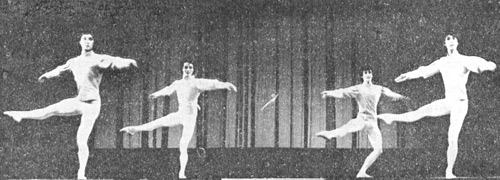|
 |
|
A scene from Sir Anton Dolln's Variations for Four (XU XIANGJUN) |
In 1956 the ballet section put on its first medium-length ballet, La Fille Mal Gardée. In 1958 Bai was selected to dance the technically-demanding double role of the black and white swans in Swan Lake. In 1960 the school established an experimental company (the fore-runner of the Central Ballet) with Bai as principal dancer. During this time she performed the leads in Le Corsaire, Giselle, Fountains of Bakhchisarai and Notre-Dame de Paris.
In 1964 the company staged its first Chinese ballet, The Red Detachment of Women, with Bai in the central role. Having as a theme the clash of a young woman's fiercely independent spirit with the oppressive institutions of the old society, the ballet was the first to meld traditional ballet technique with elements of the Chinese folk dance idiom.
During the "cultural revolution" (1966-76), Bai was sentenced to hard labour and was forbidden to perform or train for eight years. When the gang of four was toppled, she returned to the stage only after engaging in a rigorous programme to retrain herself. Taking up again her famous role in Swan Lake she was able to give her portrayal of the dying swan an added poignancy, derived from her own life's difficulties which had given her much insight into the role. At that time Bai was already over 40 and vice-director of Central Ballet. Praised for the bravura of her dancing, she modestly deflected attention from herself, suggesting there were many younger dancers who could equal or better her performance.
Central Ballet sees its function as introducing classical Western dance dramas and modern works to China, while at the same time experimenting with ways of expressing aspects of the Chinese life experience through dance, in order to make ballet more relevant to and better appreciated by Chinese audiences.
Since the 1950s, Chinese ballets have been strongly influenced by the style of the Soviet school. However, in the last few years dance in China has developed rapidly and gone through some changes. Frequent contact and exchanges with dancers from abroad, facilitated by China's policy of opening up to the outside world, has encouraged artists to emancipate their minds and widen their creative field of vision. As part of this trend, ballet repertoire has been expanded to include French works such as Sylvia and works in the Danish school. Dance experts and composers from Great Britain, the United States, the Federal Republic of Germany, France, Japan, Austria and Peru have been invited in recent years to supervise the staging of their works and to hold master classes.
Whether newly choreographed Chinese ballets such as The Maid of the Sea and New Year's Sacrifice can be placed on a par with ballet treasures such as Giselle and Swan Lake is hard to say. However, one cannot deny the choreographers' enthusiasm in contributing the best of their creative ability to ballet. Li Chengxiang, Central Ballet's director and one of the choreographers of Maid, said after a performance of his ballet based upon the famous Chinese 18th century novel A Dream of Red Mansions, "I am not seeking applause. My goal is to have my choreographies express the special characteristics of the Chinese people in order to let others fully appreciate the beauty of our national heritage."
Certainly among the younger members of the company there is no lack of choreographers concerned with absorbing elements of modern dance into their creations. A recent experimental piece in this vein called Searching for the Light attempts to use the techniques and structure of modern ballet to express the theme of a young Chinese woman's search for meaning and truth in life. Though this work is somewhat immature, it has been welcomed by audiences and has received public recognition.
One thing is definite, however. In the short period of its 25-year history, Central Ballet has come a long way; with the company's talented dancers and creative choreographers working hard, ballet in China has much promise for the future. | 